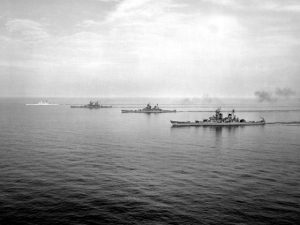So, it’s time for the Cold War battleships to sail again, simply because I’ve been looking up a lot of information on their hypothetical modifications. And what I saw was interesting enough to write about.
First, the 1980s reactivation of the Iowas. Historically, their modifications were minor in comparison to some of the other proposals. Updating their electronics to sync with the current fleet and adding Harpoon and Tomahawk launchers (the latter being, more so than the guns, the reason they were restored) was the extent of refitting. But the planned and proposed “Phase II” reactivations included more radical proposals for removing main turrets and replacing them with more missile tubes, a flight facility for helicopters and/or Harriers, or both.
The flight deck proposal was another version of the amphibious assault Iowa proposed in the 1960s, with the same problems. Those problems being “the blast from the main guns interfering with flight operations” and “mixing a close bombardment ship with one specifically designed to stay as far back as it can”.
Of course, a ship is only as good as the weapons it fires, and there were plans in the works for enhancing the Iowa’s main guns with different ammunition. The concept of using necked-down sabot rounds to enhance range was pursued to varying degrees. One of the most feasibly designed was the EX-148 projectile, viewed with other Iowa rounds here. The EX-148, even with an upgraded fire control system to go alongside it, was still imprecise enough to require a cluster warhead. As such, according to one of the most detailed studies, it was a specialty round designed for the role of beating back massed counterattacks against a hypothetical beachhead.
Contrasted with that actually-developed round are the flights of fancy that regularly emerged from the now-defunct US Naval Fire Support Association. Guided rounds, scramjet rounds going to ranges the EX-148 could only dream of, and of course the two combined. The most detailed examination of these exotic rounds was made in a 2007 study by colonel (and USNFSA member) Shawn Welch. In the squabbling battleship community online, the study was heavily criticized despite its unquestionably detailed and advanced simulations. My critiques (even without the technical knowledge) are twofold. Welch handwaves development costs and capabilities of his exotic rounds, and his threat example involves returning to the 90s bugaboo of a large but low-end force attacking a US deployment.
Any talk of the unquestionable expense of battleship operations cannot be made in a vacuum. The opportunity costs, applicable to even the US on a defense binge, always loom upwards. And there the BBs are found wanting. The lost supply infrastructure for battleships was already a problem in the 1980s and only got worse. Any sort of limited budgets mean that niche projects (which battleships inherently remain) are frequently the first to go. The requirement for shore support of Marine amphibious operations that have never actually been conducted in anger has led to overexpensive and frequently shelved projects like the ERGM, LASM, and now the LRLAP. This implies difficulty if the scramjet rounds were actually developed in any sort of detail.
That being said, in fantasy the battleship maintains its appeal. The weird fusion of post-USSR operational concepts and extended Cold War stuff like the upgraded shells is something I have an inexplicable liking of. EX-148s or the goofball super-shells being one of the weapons in the arsenal of the Sea Dragon/Hunter Warrior/Distributed Operations teams brings a strange smile to my face. What I also like is the absurdist (but accurate) sight of a battlecarrier standing off and launching its aircraft with the gun crews joking about their own worthlessness.
One final note involves an interesting coincidence of names. The battleships were not the only big-gun warships considered for reactivation. The Des Moines class of cruisers was considered as well-in the same “packed ABL Tomahawks first, guns second” role. Des Moines is the capitol of Iowa.
_ _ _ _ _ _
This got me thinking of the other side of the Cold War, and a possible niche for Stalin’s big fleet. It’s not a truly practical one by any stretch of the imagination. Opportunity costs, bad enough to give an established navy that outnumbered the rest of the world pause, would be far worse for a land power that has to build everything from scratch. The inspiration came from Soviet/Russian land doctrine. Artillery was and is the cornerstone of their ground forces. Applying existing platforms to give its naval infantry the same firepower for their jaunts to Norway or Hokkaido is at least a nominally viable concept, and works better than trying to reenact Jutland.
There are still massive, massive issues. First, in the same period the postwar battleships would have been built, the Naval Infantry was outright disbanded as part of the drawdown. Even if they’d been kept and emphasized, amphibious craft would be necessary. Comparing them to battleships in terms of priority is like comparing water to a hot fudge sundae in terms of basic survival. Third, the advantages battleships would have over existing cruisers like the Chapeav and Sverdlov would be limited and arguably cost-ineffective for a navy that would have to fight for every last ruble.
That being said, for the sake of enjoyable fantasy, a gun-line supporting a 50s-60s amphibious hook has an appeal on its own.
Note: The Warships1 Forum, particularly this thread , was an invaluable resource. Credit is given to all the contributors there.



